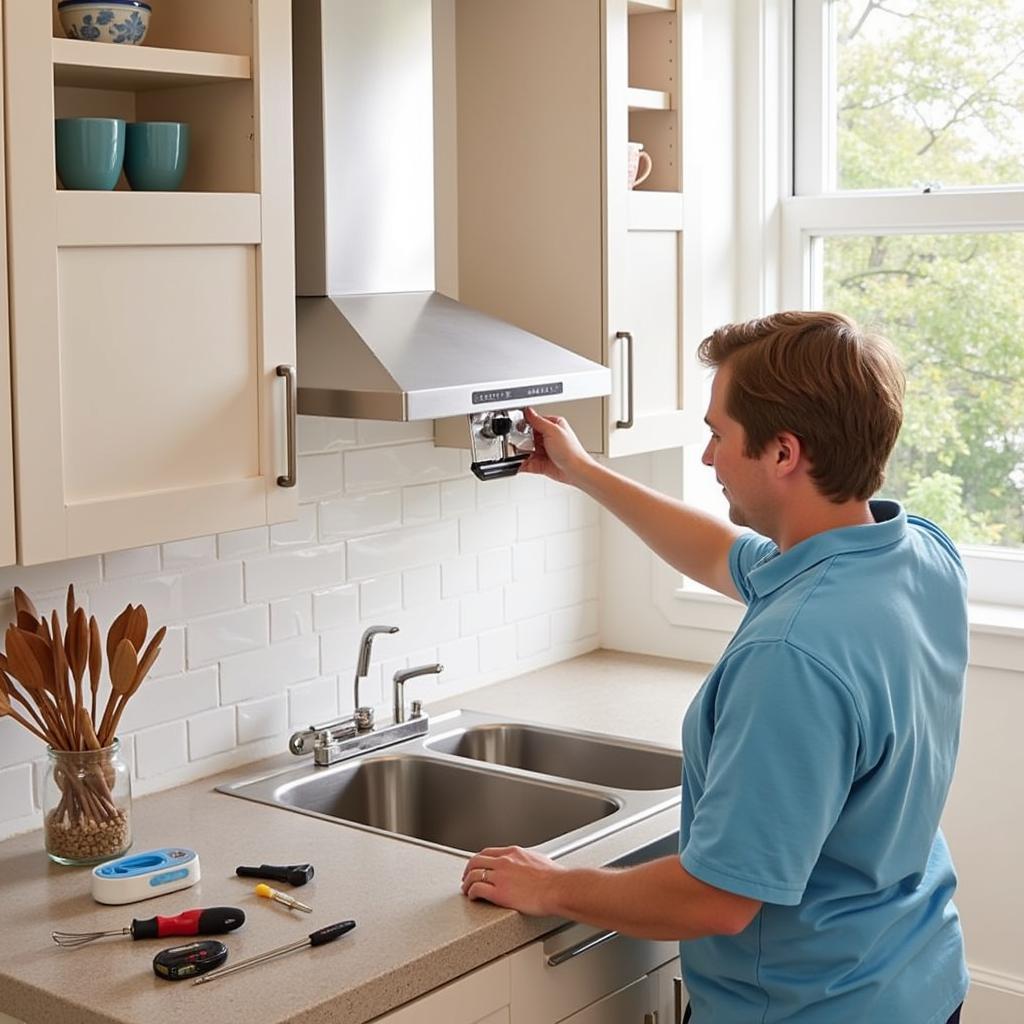A Diy Kitchen Exhaust Fan can be a rewarding project for homeowners who want to improve their kitchen’s air quality and save on installation costs. This comprehensive guide will walk you through everything you need to know about choosing, installing, and maintaining your own kitchen exhaust fan.
 DIY Kitchen Exhaust Fan Installation
DIY Kitchen Exhaust Fan Installation
Understanding Kitchen Exhaust Fans and Why You Need Them
Before diving into the DIY aspect, it’s crucial to understand the importance of a well-functioning kitchen exhaust fan. Cooking generates heat, smoke, grease, and odors that can negatively impact your kitchen environment and overall home air quality.
A [kitchen exhaust fan replacement](https://fansbongda.com/kitchen-exhaust-fan replacement/) effectively removes these airborne pollutants, improving air circulation, reducing moisture buildup (which can lead to mold), and creating a cleaner, healthier, and more pleasant cooking experience.
Choosing the Right DIY Kitchen Exhaust Fan
Selecting the right exhaust fan for your kitchen is essential for optimal performance. Here are key factors to consider:
- Fan Type: Common types include under-cabinet, wall-mounted, and ceiling-mounted fans. Consider your kitchen layout and existing ductwork.
- CFM Rating: This measures airflow capacity (cubic feet per minute). Choose a fan with a CFM rating appropriate for your kitchen size and cooking habits.
- Noise Level: Look for fans with a low sone rating, especially if your kitchen is open to other living areas.
- Features: Consider features such as multiple fan speeds, lighting options, and automatic timers for added convenience.
Essential Tools and Materials
Gathering the necessary tools and materials beforehand will make your DIY installation smoother. You’ll typically need:
- Safety Gear: Safety glasses, work gloves, and a dust mask.
- Measuring Tools: Tape measure, level, and pencil.
- Power Tools: Drill, jigsaw (if cutting through walls or cabinets), and screwdriver.
- Electrical Supplies: Electrical cable, wire connectors, and electrical tape.
- Ductwork: Flexible or rigid ductwork, depending on your setup.
- Mounting Hardware: Screws, bolts, and brackets.
 Kitchen Exhaust Fan Parts
Kitchen Exhaust Fan Parts
Step-by-Step Installation Guide
Follow these general steps for installing your DIY kitchen exhaust fan:
- Turn off the power: Disconnect the electricity to the area where you’ll be working.
- Prepare the installation area: If replacing an existing fan, carefully remove it and clean the surrounding area.
- Install the mounting bracket: Securely attach the mounting bracket to the wall or cabinet.
- Connect the ductwork: Attach the ductwork to the fan housing and run it to the exterior vent.
- Connect the electrical wiring: Connect the fan’s wiring to the electrical supply, following local codes and manufacturer instructions.
- Mount the fan: Secure the fan housing to the mounting bracket.
- Seal and insulate: Seal any gaps around the fan and ductwork with caulk or weatherstripping.
- Test the fan: Turn the power back on and test the fan’s operation.
Maintenance Tips for Optimal Performance
Regular maintenance will ensure your DIY kitchen exhaust fan continues to function efficiently and effectively:
- Clean or replace filters: Check and clean or replace filters every 3 months, or more frequently if you cook often.
- Clean the fan blades and housing: Wipe down the fan blades and housing with a damp cloth every few months.
- Inspect the ductwork: Check for any blockages or leaks in the ductwork periodically.
Frequently Asked Questions (FAQs)
How do I know if my kitchen exhaust fan is working properly?
Hold a thin piece of paper up to the fan while it’s running. If the paper is held firmly against the grille, the fan is drawing air effectively.
Can I vent my kitchen exhaust fan into the attic?
No, venting into the attic can lead to moisture buildup and potential damage to your roof. Always vent to the exterior of your home.
How often should I run my kitchen exhaust fan?
Run your fan whenever you are cooking, especially when using the stovetop or oven.
 Cleaning Kitchen Exhaust Fan Filter
Cleaning Kitchen Exhaust Fan Filter
Need More Help?
For all your ventilation needs, explore our range of commercial ventilation fans and centrifugal plug fans. We also offer innovative solutions like the bluetooth speaker exhaust fan light for a modern touch to your kitchen.
Contact us today at 0903426737 or fansbongda@gmail.com. Our dedicated team is available 24/7 to assist you. You can also visit our address at tổ 9, khu 6, phường Giếng Đáy, tp. Hạ Long, Giếng Đáy, Hạ Long, Quảng Ninh, Vietnam.


